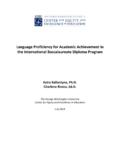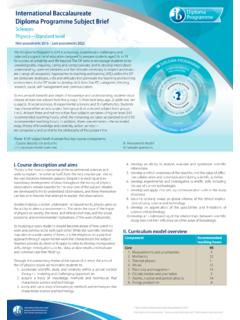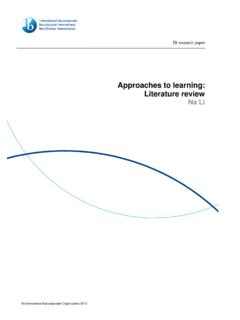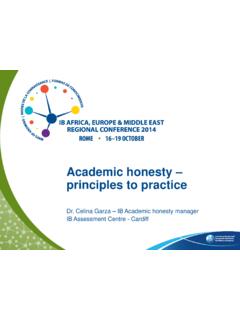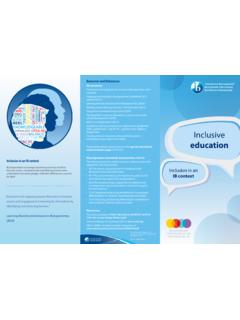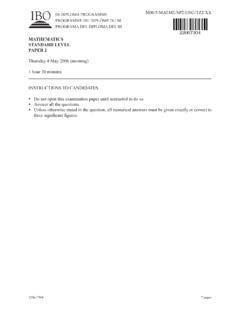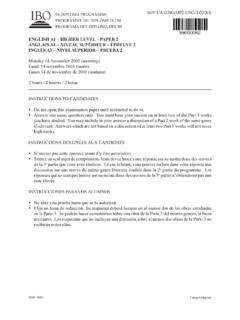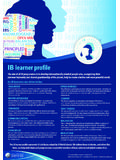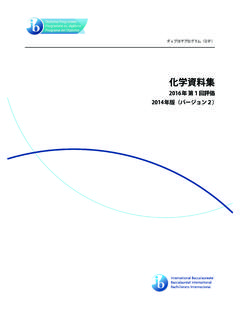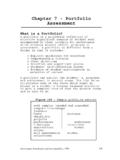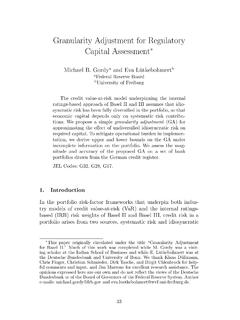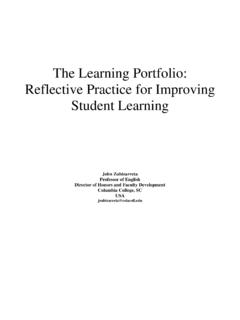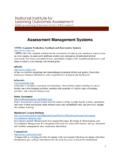Transcription of Assessment of Student Development and Learning …
1 Final Report November 2015 AUTHORS Dianne Toe, Josephine Lang, Louise Paatsch, Bonnie Yim, Wendy Jobling, Brian Doig and George Aranda Assessment of Student Development and Learning in IB PYP Schools International Baccalaureate Organisation Prepared by the School of Education, Deakin University Assessment of Student Development and Learning in IB PYP Schools Final Report ii Table of Contents Executive Summary .. iii List of Figures .. ix List of Tables .. ix List of Abbreviations .. x Introduction .. 1 Background to the 3 Making the IB PYP happen: perspective on Assessment .
2 3 Assessing Student Learning .. 5 Recording Student Learning .. 6 Reporting Student Learning .. 6 Summary of Harlen and Johnson (2014) .. 6 Research Design .. 10 Themes from a review of recent literature on Assessment .. 10 Literature review approach .. 10 Analysis of literature review data .. 10 Research Process .. 16 Structure of the IB PYP Assessment multiple case study research project .. 16 Ethics approval .. 17 Rationale for data collection sampling method .. 18 Recruitment of schools .. 18 Data collection .. 19 Data analysis .. 21 Findings.
3 24 Teacher survey (whole group) .. 24 Case studies .. 32 Cross-case analysis .. 83 Key Findings and Recommendations .. 111 Recommendations for Future Research .. 116 References .. 117 Appendix A: Ethics Documents .. 122 Appendix B: Teacher Survey .. 139 Appendix C: PYP Coordinator Questions .. 150 Appendix D: Focus Group Questions .. 151 Appendix E: Case Study Procotol .. 152 Assessment of Student Development and Learning in IB PYP Schools Final Report iii Executive Summary Education systems worldwide are increasingly focusing on how to integrate Assessment with teaching to improve Student Learning and education (Shute & Becker 2010).
4 In particular, there is a growing focus on providing professional Learning opportunities for teachers that aim to develop their understandings of Assessment literacy and the various practices for implementing reliable and valid Assessment within the classroom that will inform future teaching and Learning . Furthermore, with the substantial growth of the International Baccalaureate (IB) programme across the world, the International Baccalaureate Organization (IBO) has recognised that support and future Development of the organisation s Primary Years Programme (PYP) will require information relating to how Assessment is perceived and used by teachers in the IB PYP worldwide.
5 This organisational interest is also connected with the comprehensive review of the IB PYP and the rising interest globally in better understanding the Assessment literacy of teachers. Therefore, the aim of this project was to investigate how IB PYP World Schools define the purpose of educational Assessment in their Assessment policies and their Assessment practices. This investigation offers a deeper understanding of the Assessment cultures within these IB PYP World Schools and provides insights into the current Assessment literacy of teachers. In addition, this investigation sought to identify the specific professional Learning needs and support required for teachers working in IB PYP World Schools.
6 Specifically, this project examined how IB PYP schools across the world: understand the role of evidence in Assessment and provide documentation of Student growth of knowledge, understanding and skills; provide evidence of students progress in demonstrating the IB Learner Profile; and understand the role of Assessment for the purpose of gathering evidence based on a developmental model of teaching, and use this to identify and provide Learning pathways for students with respect to developmental outcomes. This study sought to address the following key areas of inquiry: How do PYP schools define educational Assessment ?
7 How do teachers in PYP schools see the purpose of Assessment ? How do teachers in PYP schools use Assessment to plan for depth and rigour of Learning ? Assessment of Student Development and Learning in IB PYP Schools Final Report iv Literature Review The first part of this project was a literature review that built on the work of Harlen and Johnson (2014), who reviewed the literature relating to Assessment in the IB PYP for the IBO. The literature review for this project focused primarily on literature published between 2012 and 2014. It identified six key focus areas: teacher beliefs and the ways these shape Assessment practices; the way standardised testing impacts or challenges Assessment in schools and their communities; the growing culture of Assessment for Learning as part of formative Assessment practices; the need to balance formative and summative Assessment ; the recognition of the importance of Assessment of soft skills such as social and interpersonal qualities.
8 And the affordances of information and communications technology (ICT) for Assessment for, of and as Learning . Although there is interest in how developmental approaches and neuroscience might influence the field of Assessment in Learning and education, we found little research (and few empirical studies) in these areas. Research Design and Methods The empirical research was undertaken between June 2014 and October 2015. It involved a case study approach with two phases of data collection methods: a preliminary online survey, and detailed focus groups and interviews to follow up on themes identified in the survey.
9 The research questions and propositions that framed the study are shown in the following table. Eight IB PYP schools were included in the research, with three schools representing the IB Africa, Europe and Middle East, two schools representing the IB Americas and three schools representing the IB Asia-Pacific region. We selected schools carefully to ensure the research reached a wide range of IB school types. The aim of the IB PYP Assessment case studies was to develop an understanding of the way teachers in IB PYP schools see the purpose of Assessment and how they use Assessment to plan for depth and rigour of Learning .
10 To examine this proposition, the IB Assessment project explored similarities and differences between cases. The approach was driven by clear research questions, a set of propositions and well-identified data sources. The questions asked in the teacher surveys, interviews and focus groups were based on the literature review and the research questions. Assessment of Student Development and Learning in IB PYP Schools Final Report v Research questions Propositions 1. How do IB PYP schools articulate their approach to Assessment and the way it is used for supporting Student Learning ?
